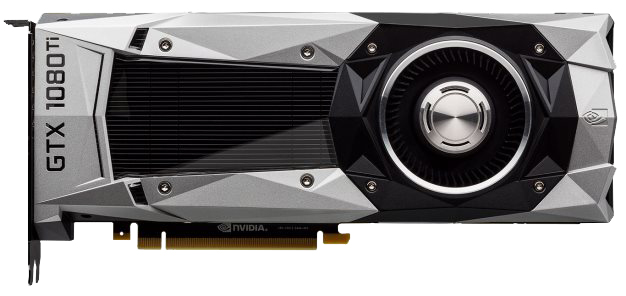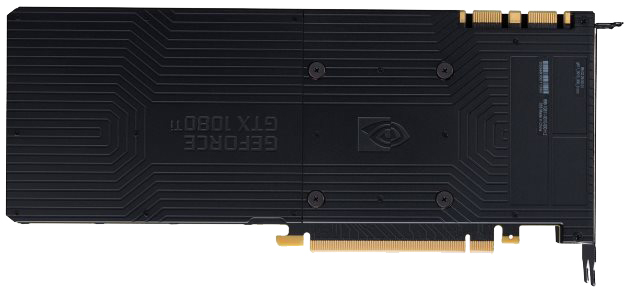NVIDIA GeForce GTX 1080 Ti Review - The Fastest Gaming Graphics Card Yet
The GeForce GTX 1080 Ti’s specifications may elicit some quizzical looks in light of previous-gen offerings, with its odd 11GB of GDDR5X RAM and 352-bit memory interface, but rest assured this card is an absolute beast. Though its memory complement, interface, and a few blocks within the GPU are reduced versus the mighty NVIDIA Titan X, the GeForce GTX 1080 Ti makes up for its “shortcomings” with a combination of refinement and brute force.
Take a look at its main features and specifications below and we’ll explain what we mean a little later. Then saddle-up for a look at some impressive benchmark numbers...
|
| NVIDIA GeForce GTX 1080 Ti | ||
| Graphics Processing Clusters | 6 | |
| Streaming Multiprocessors | 28 | |
| CUDA Cores (single precision) | 3584 | |
| Texture Units | 224 | |
| ROP Units | 88 | |
| Base Clock | 1480MHz |
|
| Boost Clock | 1582MHz |
|
| Memory Clock (Data rate) | 5505MHz (~11Gbps) | |
| L2 Cache Size | 2816KB | |
| Total Video Memory | 11264 MB GDDR5X | |
| Memory Interface | 352-Bit |
|
| Total Memory Bandwidth | 484 GB/s |
|
| Texture Filtering Rate (Bilinear) | 331.5 GigaTexels/sec |
|
| Fabrication Process | 16 nm |
|
| Transistor Count | 12 Billion | |
| Connectors | 3 x Display Port, 1 x HDMI | |
| Form Factor | Dual Slot |
|
| Power Connectors | One 8-Pin, One 6-Pin | |
| Recommended Power Supply | 600 Watts |
|
| Thermal Design Power (TDP) | 250 Watts |
|
| Thermal Threshold | 91°C |
|
| Price | $699 MSRP - Find Them At Amazon.Com | |
Unboxing NVIDIA's GeForce GTX 1080 Ti
At its core, the GeForce GTX 1080 Ti is very similar to the NVIDIA Titan X. They are both powered by the same GP102 GPU and have a similar number of active CUDA cores and texture units. The GPU used on the 1080 Ti, however, has a ROP / memory partition disabled, which results in a narrower memory bus, less memory (11GB vs. 12GB), less L2 cache (2816KB vs. 3072KB), and fewer ROP units. The GeForce GTX 1080 Ti's higher core and memory frequencies, however, make up for these differences. Here's a quick breakdown as to how it stacks up versus the Titan X and a standard GeForce GTX 1080...
| GTX 1080 Ti | TITAN X | GTX 1080 | |
| NVIDIA GPU | GP102 | GP102 | GP104 |
| Architecture | Pascal | Pascal | Pascal |
| Number of Cores | 3584 | 3584 | 2560 |
| Core Clock (Boost) | 1582 MHz | 1530 MHz | 1733 MHz |
| Memory | 11GB | 12GB | 8GB |
| Memory Clock | 11000 MHz | 10000 MHz | 10000 MHz |
| Memory Interface | 352-bit G5X | 384-bit G5X | 256-bit G5X |
| Memory Bandwidth | 484 GB/s | 480 GB/s | 320 GB/s |
| TDP | 250 watts | 250 watts | 180 watts |
| Peak Compute | 11.4 TFLOPS | 11.0 TFLOPS | 8.2 TFLOPS |
| Transistor Count | 12B | 12B | 7.2B |
| Process Tech | 16nm FinFET | 16nm FinFET | 16nm FinFET |
| MSRP | $699 | $1,200 | $499 (New price) |
To enable the higher memory frequency on the 1080 Ti, NVIDIA worked with Micron to optimize the GDDR5X memory interface and associated circuitry on the card. Power delivery and signal quality was improved, which allowed NVIDIA to crank up the memory clock to an effective 11Gbps data rate, using this premium GDDR5X memory type. Because one memory partition is disabled in the GPU, however, the memory bus connecting the GPU to the memory is slightly narrower at 352-bits wide, versus 384-bits on the Titan X - though overall memory bandwidth is actually higher for the GeForce GTX 1080 Ti, due to its higher memory clock speed.
The GPU powering the GeForce GTX 1080 Ti has a base clock of 1,480MHz and a boost clock of 1,582MHz, however. As we've mentioned, the GDDR5X memory on the card is clocked at 5.5GHz for an effective data rate of 11Gbps, which results in 484GB/s of peak memory bandwidth -- a slight improvement over the Titan X. At these clocks, the card also offers a peak texture fillrate of 331.5 GigaTexels/s, which is higher than a Titan X as well, but the card still falls within the same 250 watt power envelope. As such, the 1080 Ti requires 8-pin and 6-pin supplemental power feeds -- one each.
The GeForce GTX 1080 Ti Founder's Edition pictured here looks like a cross between a standard 1080 and the Titan X. It has a faceted fan-shroud with black and silver elements and a see-thru window, a thin, modular back-plate, and an aggressive overall design language -- it loses the mostly black theme of the Titan X, though. Should you use GeForce GTX 1080 Ti cards in SLI mode, in adjacent slots, the rear portion of the backplate is removable to allow for better airflow between the cards, as you can see below (we have additional pictures in the gallery at the bottom of the page as well, if you'd like to see more views of the card, over and above what's shown here).
The GeForce GTX 1080 Ti is outfitted with a die cast aluminum body which is machine finished and heat treated for additional strength and rigidity. The top edge of the card features the signature, lighted "GeForce GTX" logo that NVIDIA has been using for a while now, but partners are likely to introduce custom designs with different logos, lighting, etc. The thermal solution on the GTX 1080 Ti is similar to the Titan X's, but the vapor chamber has been redesigned for better performance. The cooler features a radial fan and a relatively large vapor chamber linked to a dense heatsink fin array, that vents heated air outside the chassis. At the rear of the card, a second, small heatsink helps wick heat away from the VRM.
The GeForce GTX 1080 Ti features a 7+2-phase, 2x dual-FET power array for its GPU and memory, extra capacitance in its filtering circuitry, and a power delivery network on its PCB that has been optimized for low impedance. All told, these elements result in a quieter more power efficient card. The 7-phase, 2x dual-FET power design, which is comprised of 14 high-efficiency dual FETs, is capable of supplying up to 250 amps of power to the GPU, with less wasted heat than previous-gen offerings.
The outputs on the GeForce GTX 1080 Ti have been tweaked versus previously-released, Pascal-based cards too. The outputs on the 1080 Ti consist of a trio of full-sized DisplayPorts and an HDMI 2.0b output -- the DVI port is gone, but NVIDIA did include an adapter in the box should someone want to use DVI. The DisplayPorts enable support for 4K displays at 120Hz, 5K displays at 60Hz, and 8K displays at 60Hz (using two cables and multi-stream transport). Up to four display outputs can be used simultaneously for multi-monitors, VR setups, and the like.
And now, for some benchmarks and overclocking...














